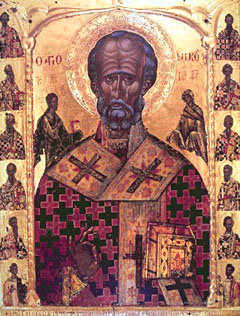| St. Nicholas  Born: fl. 3rd c. AD Born: fl. 3rd c. AD
Died: fl. 3rd c. AD
Cause of death: unspecified
Gender: Male
Religion: Roman Catholic
Race or Ethnicity: White
Occupation: Religion Executive summary: Patron saint of Russia St. Nicholas, bishop of Myra, in Lycia, a saint honored by the Greeks and the Latins on the 6th of December. His cult is as celebrated as his history is obscure. All the accounts that have come down to us are of a purely legendary character, and it is impossible to find any single incident confirmed historically.
The main facts of his life are usually given as follows. He was bishop of Myra in the time of the emperor Diocletian, was persecuted, tortured for the faith, and kept in prison until the more tolerant reign of Constantine the Great, and was present at the council of Nicaea. It should be observed that this last circumstance is ignored by all the historians, and that St. Athanasius, who knew all the notable bishops of the period, never mentions Nicholas, bishop of Myra.
The oldest known monument of the cult of St. Nicholas seems to be the church of SS Priscus and Nicholas built at Constantinople by the emperor Justinian. In the West, the name of St. Nicholas appears in the 9th century martyrologies, and churches dedicated to him are to be found at the beginning of the 11th century. It is more especially, however, from the time of the removal of his body to Bari, in Apulia, that his cult became popular. The inhabitants of Bari organized an expedition, seized his remains by means of a ruse, and transported them to Bari, where they were received in triumph on the 9th of May 1087, and where the foundations where laid of a new basilica in his honor. This was the origin of a famous and still popular pilgrimage.
There are nearly 400 churches in England dedicated to St. Nicholas. He is the patron saint of Russia; the special protector of children, scholars, merchants, and sailors; and is invoked by travellers against robbers. In art St. Nicholas is represented with various attributes, being most commonly depicted with three children standing in a tub by his side. Of the various interpretations of this, none is absolutely certain. One explanation has been sought in the legend of St. Nicholas miraculously restoring to life three rich youths who had been murdered, cut up and concealed in a salting tub by a thievish innkeeper or butcher, in whose house they had taken lodging.
A legend of his surreptitious bestowal of dowries upon the three daughters of an impoverished citizen, who, unable to procure fit marriages for them, was on the point of giving them up to a life of shame, is said to have originated the old custom of giving presents in secret on the Eve of St. Nicholas, subsequently transferred to Christmas Day. Hence the association of Christmas with "Santa Claus", an American corruption of the Dutch form "San Nicolaas", the custom being brought to America by the early Dutch colonists. Canonization
Do you know something we don't?
Submit a correction or make a comment about this profile
Copyright ©2019 Soylent Communications
|